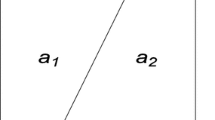Abstract
The paper deals with the construction of interpretable machine learning models. The approximation problem is solved for a set of shapes on a contour image. Assumptions that the shapes are second-order curves are introduced. When approximating the shapes, information about the type, location, and shape of curves as well as about the set of their possible transformations is used. Such information is called expert information, and the machine learning method based on expert information is called expert-augmented learning. It is assumed that the set of shapes is approximated by the set of local models. Each local model based on expert information approximates one shape on the contour image. To construct the models, it is proposed to map second-order curves into a feature space in which each local model is linear. Thus, second-order curves are approximated by a set of linear models. In a computational experiment, the problem of approximating an iris on a contour image is considered.










Similar content being viewed by others
REFERENCES
He, K., Ren, S., Sun, J., and Zhang, X., Deep Residual Learning for Image Recognition, Proc. IEEE Conf. Comput. Vis. Pattern Recognit. (Las Vegas, 2016), pp. 770–778.
Ribeiro, M., Singh, S., and Guestrin, C., Why should I trust you?: Explaining the predictions of any classifier, Proc. 22nd ACM SIGKDD Int. Conf. Knowl. Discovery Data Min. (2016), pp. 1135–1144.
Han, X., Yao, M., Debayan, D., Hui, L., Ji-Liang, T., and Anil, J., Adversarial attacks and defenses in images, graphs and text: A review, Int. J. Autom. Comput., 2020, vol. 17, pp. 151–178.
Akhtar, N. and Mian, A., Threat of adversarial attacks on deep learning in computer vision: A survey, IEEE Access, 2018, vol. 6, pp. 14410–14430.
Grabovoy, A. and Strijov, V., Probabilistic interpretation of the distillation problem, Autom. Remote Control, 2022, vol. 83, pp. 123–137.
Matveev, I., Detection of iris in image by interrelated maxima of brightness gradient projections, Appl. Comput. Math., 2010, vol. 9, pp. 252–257.
Matveev, I. and Simonenko, I., Detecting precise iris boundaries by circular shortest path method, Pattern Recognit. Image Anal., 2014, vol. 24, pp. 304–309.
Bowyer, K., Hollingsworth, K., and Flynn, P., A survey of iris biometrics research: 2008–2010, in Handbook of Iris Recognition, 2010, pp. 15–54.
Salamani, D., Gadatsch, S., Golling, T., Stewart, G., Ghosh, A., Rousseau, D., Hasib, A., and Schaarschmidt, J., Deep generative models for fast shower simulation in ATLAS, IEEE 14th Int. Conf. e-Sci. (2018), pp. 348–348.
Chen, Xi. and Ishwaran, H., Random forests for genomic data analysis, Genomics, 2012, vol. 6, pp. 323–329.
Chen, T. and Guestrin, C., XGBoost: A scalable tree boosting system, Proc. 22nd ACM SIGKDD Int. Conf. Knowl. Discovery Data Min. (2016), pp. 785–794.
Yuksel, S., Wilson, J., and Gader, P., Twenty years of mixture of experts, IEEE Trans. Neural Networks Learn. Syst., 2012, vol. 8, pp. 1177–1193.
Dempster, A., Laird, N., and Rubin, D., Maximum likelihood from incomplete data via the EM algorithm, J. R. Stat. Soc. Ser. B (Methodol.), 1977, vol. 39, pp. 1–38.
Ebrahimpour, R., Moradian, R., Esmkhani, A., and Jafarlou, F., Recognition of Persian handwritten digits using characterization loci and mixture of experts, J. Digital Content Technol. Appl., 2009, pp. 42–46.
Peng, F., Jacobs, R., and Tanner, M., Bayesian inference in mixtures-of-experts and hierarchical mixtures-of-experts models with an application to speech recognition, J. Am. Stat. Assoc., 1996, vol. 91, pp. 953–960.
Grabovoy, A. and Strijov, V., Prior distribution selection for a mixture of experts, Comput. Math. Math. Phys., 2021, pp. 1140–1152.
Estabrooks, A. and Japkowicz, N., A mixture-of-experts framework for text classification, Proc. Workshop Comput. Nat. Lang. Learn. Assoc. Comput. Linguist. (2001), pp. 1–8.
Cheung, Y., Leung, W., and Xu, L., Application of mixture of experts model to financial time series forecasting, Proc. Int. Conf. Neural Network Signal Process. (1995), pp. 1–4.
Weigend, A. and Shi, S., Predicting daily probability distributions of S&P500 returns, J. Forecast., 2000, vol. 19, pp. 375–392.
Cao, L., Support vector machines experts for time series forecasting, Neurocomputing, 2003, vol. 51, pp. 321–339.
Mossavat, S., Amft, O., Vries, B., Petkov, P., and Kleijn, W., A Bayesian hierarchical mixture of experts approach to estimate speech quality, Proc. 2nd Int. Workshop Qual. Multimedia Expert. (2010), pp. 200–205.
Sminchisescu, C., Kanaujia, A., and Metaxas, D., Discriminative density propagation for visual tracking, IEEE Trans. Pattern Anal. Mach. Intell., 2007, vol. 29, pp. 2030–2044.
Tuerk, A., The state based mixture of experts HMM with applications to the recognition of spontaneous speech, Ph.D. Thesis, Univ. Cambridge, 2001.
Yumlu, M., Gurgen, F., and Okay, N., Financial time series prediction using mixture of experts, Proc. 18th Int. Symp. Comput. Inf. Sci. (2003), pp. 553–560.
Funding
This work was financially supported by the Russian Foundation for Basic Research within the framework of scientific project no. 20-07-0090.
Author information
Authors and Affiliations
Corresponding authors
Additional information
Translated by V. Potapchouck
Rights and permissions
About this article
Cite this article
Bazarova, A.I., Grabovoy, A.V. & Strijov, V.V. Analysis of the Properties of Probabilistic Models in Expert-Augmented Learning Problems. Autom Remote Control 83, 1527–1537 (2022). https://doi.org/10.1134/S00051179220100058
Received:
Revised:
Accepted:
Published:
Issue Date:
DOI: https://doi.org/10.1134/S00051179220100058




